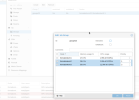Hi,
I'm testing some edge cases with proxmox VE 6.3: I have a cluster p1 with three nodes node1 node2 node3, all use only a shared NFS (from another machine outside the cluster) for VM disk storage.
VM 100 is running on node1. node2 and node3 have no VM running.
Let's assume node1 fails (poweroff because power supply failure) and won't be repaired immediately (no spare handy), so I want to manually start VM 100 on node2 but I don't want to remove node1 from the cluster (because it will be repaired in the coming days).
I noticed on node2 and node3 there is a copy of the VM 100 info on node2 and node3 in /etc/pve/node1/qemu-server/100.conf and the disk is on shared NFS so nothing is lost even if node1 if offline.
I didn't find an obvious way to do it via the proxmox VE WebUI, did I miss something?
Thanks!
I'm testing some edge cases with proxmox VE 6.3: I have a cluster p1 with three nodes node1 node2 node3, all use only a shared NFS (from another machine outside the cluster) for VM disk storage.
VM 100 is running on node1. node2 and node3 have no VM running.
Let's assume node1 fails (poweroff because power supply failure) and won't be repaired immediately (no spare handy), so I want to manually start VM 100 on node2 but I don't want to remove node1 from the cluster (because it will be repaired in the coming days).
I noticed on node2 and node3 there is a copy of the VM 100 info on node2 and node3 in /etc/pve/node1/qemu-server/100.conf and the disk is on shared NFS so nothing is lost even if node1 if offline.
I didn't find an obvious way to do it via the proxmox VE WebUI, did I miss something?
Thanks!


